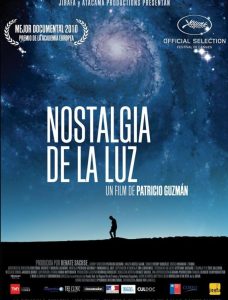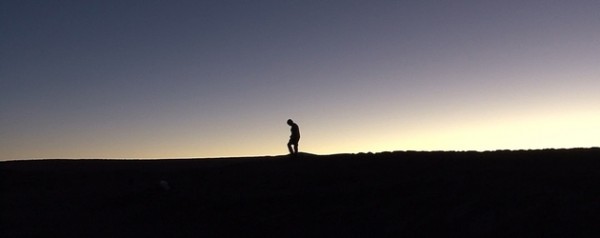
The Atacama Desert is perhaps the driest place on earth; extending into the Andes mountain range in Chile, some areas have had no rainfall for over 400 years. It is at a high altitude, with bitterly cold temperatures, supporting very little life. The utter lack of humidity makes the Atacama ideal for two things: astronomy and preservation of corpses. These seemingly disparate subjects become the focus of the meditative Nostalgia for the Light, a documentary that considers the similarities between the pursuits found in one of the loneliest places in the world. The camera silently pans across the imposing structure of a massive telescope; it overlooks a pan below, dotted with people sifting through the clay and dirt for human remains. The inquisitive narrator (director Patricio Guzman) seeks the unseen connections between these pursuits, the questions best described as ‘Herzog-lite’. This is not a bad thing, as another straightforward documentary on genocide is hardly what would most likely inform a likely jaded audience. Instead, we are guided along an unusual path, prodded by (sometimes too much) the questions asked of the people found in this strange place.
Static shots of a silent moon, an enhanced photo of a distant galaxy, star clusters, all lovely moments frozen in time, made possible by the telescopes of the desert. These unblinking eyes, along with an array of radiotelescopes, receive visual and energy signals from bodies that are billions of years old. Time is a dimension as much as any direction, with no object remaining the same as time passes; the structures emitting this radiation perhaps no longer exist at the moment; we will probably never know. The physicists tirelessly comb the sky for clues about the origin of the universe – they dig into the past.
When Salvador Allende’s embattled tenure came to an end with the military coup that brought Pinochet to power and ended Allende’s life, Chile was plunged into repression. The ‘disappearances’ came soon after, with over 27,000 people reported tortured (and likely more that never stepped forward), and thousands of others never heard from again. Guzman’s camera plays across an abandoned mining camp; in the Atacama desert was Pinochet’s first concentration camp, where an untold number of people were worked to death and buried nearby. There is a dense graveyard where the slowly decaying bodies are relentlessly shaken by the indifferent wind. Desiccated books and dirty clothing cling to existence; these details make Nostalgia for the Light rich in atmosphere. We are transported to another time, and much like the stars photographed, we perceive only echoes of what transpired. The death camps were filled with political prisoners and intellectuals, some of whom fashioned crude telescopes to continue their work of cataloging the contents of the heavens. Not even torture could persuade them to stop the search.
Guzman has a remarkable sense of the absurd, and the people he interviews seem to enjoy the paradoxes presented to them. While the scientists work ceaselessly to unearth the past, Chile could not forget its past soon enough. The women who spend their days digging for the slightest hint of bone or cloth in this vast desert demand closure, and are aggressively ignored by society and the government. “It suits them that there are less and less of us women. We are Chile’s leprosy.” A historian points out that there is something immoral about forgetting the dead, and so these women bear an unimaginable pain. The country has yet to really come to terms with its past, and so views any digging with great discomfort. This may sound exploitative, but Nostalgia for the Light comes off as detached. Amongst the many memorable shots, one stands out for me: the women who wander the desert are invited into the telescope to view the cosmos, as if to transcend the pain for a little while. In the infinite expanses of space, Chile and its problems are rendered utterly insignificant; yet any hard-won understanding of ourselves is as profound as the discovery of a galaxy. The narrator dryly intones “Those with no memory of the past live nowhere.”
There is a vast repository of history in this desert; some of the mummified remains of the ancient peoples who inhabited this place date back 9000 years. Nobody worries about those bodies since anyone who would lose something by the discovery is long dead. Perhaps the terrible excesses of the Pinochet regime will be easier to dig up once the potentially offended have joined those they murdered. During the filming of Nostalgia for the Light, a body was apparently found. One woman can finally lay their loved one to rest, while the rest are given hope again, empowered to continue their inexorable vigil.
The beautiful photography and remarkable visualization of solitude along with the odd subject matter creates a haunting work that sends the mind to strange places. The expanse of the desert is stunning, and yet compared to the span of our galaxy it is infinitesimal, an infinity on top of infinity. The focus of the film is allowed to drift as interviewed subjects consider how science is coming to redefine religion, the deceptive nature of appearance and how time renders true appearances meaningless, and an interesting metaphor for Chile. A former prison camp inmate traces his cell, building, and entire camp with accompanying pictures detailing work regimes and torture devices, all from memory, much to the chagrin of the ruling party. His wife has Alzheimer’s dementia; he remembers, while she forgets. Though Nostalgia for the Light has more than its share of tangents, they are welcome journeys. This is one of the more fascinating works of the year, and one that bears revisiting. The stark photography is a treasure, the unusual topic a challenge, and the probing questions prompting us to reflect on the limitations of truth and the equally compelling human desires to discover and forget.

